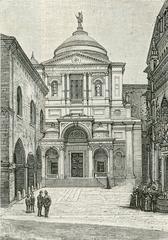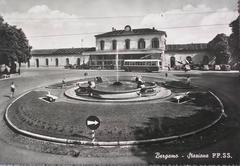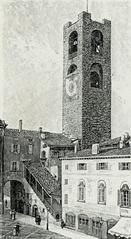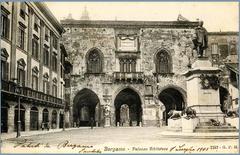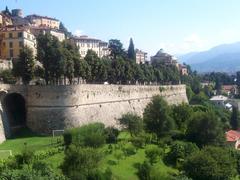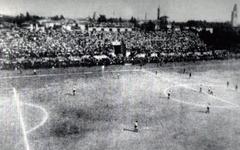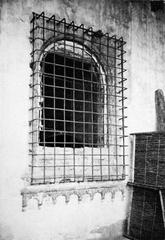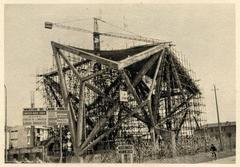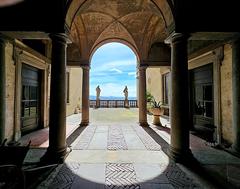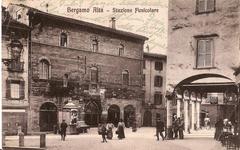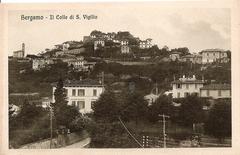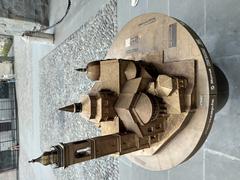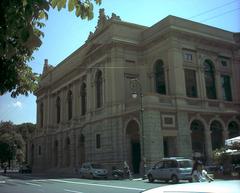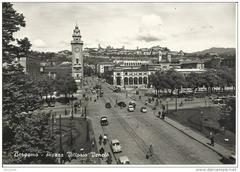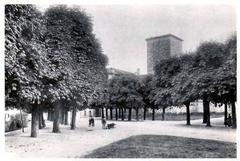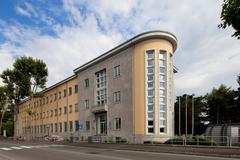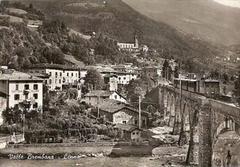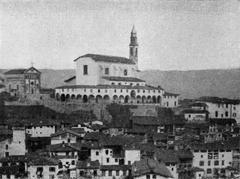Visiting Hours, Tickets, and History of Centrale Idroelettrica di Crespi d’Adda in Bergamo, Italy
Date: 01/08/2024
Introduction
The Centrale Idroelettrica di Crespi d’Adda, located in the Bergamo province of Italy, stands as a remarkable testament to early 20th-century industrial ingenuity and architectural beauty. Established in 1909 by the influential Crespi family, this hydroelectric power plant was constructed to meet the energy demands of the Crespi d’Adda cotton mill and the surrounding workers’ village (Crespi d’Adda). The plant exemplifies the Liberty Lombardo style, a regional variant of Art Nouveau, and possesses significant historical and technological value. Over the years, the Centrale Idroelettrica has undergone numerous restorations, ensuring the preservation of its original features while integrating modern technological advancements. Recognized as part of the Crespi d’Adda workers’ village, a UNESCO World Heritage Site since 1995, the plant not only continues to generate power but also serves as an educational and cultural landmark that attracts visitors from around the world (Wikipedia). This guide provides a comprehensive overview of the Centrale Idroelettrica di Crespi d’Adda, covering its rich history, visitor information, and practical tips for an enriching visit.
Table of Contents
- History of Centrale Idroelettrica di Crespi d’Adda
- The Origins and Construction of Centrale Idroelettrica di Crespi d’Adda
- Architectural Significance of Centrale Idroelettrica di Crespi d’Adda
- Technological Evolution of Centrale Idroelettrica di Crespi d’Adda
- Restoration and Public Access to Centrale Idroelettrica di Crespi d’Adda
- UNESCO World Heritage Site
- Visitor Experience
- Practical Information
- Significance and Legacy
- Conclusion
History of Centrale Idroelettrica di Crespi d’Adda
The Origins and Construction of Centrale Idroelettrica di Crespi d’Adda
The Centrale Idroelettrica di Crespi d’Adda, located in Bergamo, Italy, is a significant example of early 20th-century industrial architecture and engineering. Established in 1909, the power plant was built to meet the growing energy demands of the Crespi d’Adda cotton mill and the surrounding workers’ village. The Crespi family, prominent industrialists in the region, drove the decision to build the hydroelectric plant to ensure a reliable and sustainable energy source for their industrial activities.
Strategically placed near an older hydromechanical plant, the construction of the power plant leveraged the water flow from the Adda River. The official inauguration took place on July 25, 1909, chosen to coincide with the feast day of Saint Christopher, the protector of waters, highlighting the importance of water in the plant’s operations and the community’s daily life.
Architectural Significance of Centrale Idroelettrica di Crespi d’Adda
Renowned for its architectural beauty, the Centrale Idroelettrica di Crespi d’Adda showcases the late Liberty Lombardo style, also known as Art Nouveau. This style is evident in the intricate decorations and the use of original materials such as parquet flooring. The plant’s design includes ornate details that reflect the aesthetic values of the period, making it not only a functional industrial facility but also a visual landmark.
One of the most striking features is its control panel and turbine heads, preserved and restored from the original construction in 1909. These elements offer visitors a glimpse into the technological advancements of the early 20th century, earning the plant recognition as a jewel of industrial archaeology.
Technological Evolution of Centrale Idroelettrica di Crespi d’Adda
Initially equipped with three Kaplan turbines, known for their vertical axis and complete submersion in water, the plant allowed for efficient horizontal rotation and energy generation. Over the years, the plant underwent several upgrades to improve its efficiency and output.
Despite its early success, the plant fell into disuse by 2009. However, in 2015, the Società Adda Energia, part of the Gruppo Iniziative Bresciane Spa, acquired the facility and began a comprehensive restoration project. The restoration aimed at reviving the plant’s operations while maintaining its historical integrity and updating its technological components to meet modern standards.
Restoration and Public Access to Centrale Idroelettrica di Crespi d’Adda
The meticulous restoration of the plant focused on both structural and aesthetic enhancements. Completed in 2015, the plant was reopened to the public, offering guided tours that highlight its historical and technological aspects.
Today, the Centrale Idroelettrica di Crespi d’Adda operates as a fully functional hydroelectric plant, generating power while serving as an educational and cultural site. Visitors can explore the plant’s interior, view the original machinery, and learn about the history of hydroelectric power in the region. Guided tours provide an in-depth look at the plant’s operations, including the role of water flow from Lecco, which must exceed 120 cubic meters per second to activate the turbines.
UNESCO World Heritage Site
The Centrale Idroelettrica di Crespi d’Adda is part of the Crespi d’Adda workers’ village, designated a UNESCO World Heritage Site in 1995. This designation recognizes the village as an outstanding example of a 19th and early 20th-century company town. The hydroelectric plant played a crucial role in the village’s development, providing the necessary energy to sustain the cotton mill and the community.
The UNESCO designation has helped preserve the historical and cultural heritage of Crespi d’Adda, attracting visitors from around the world. The hydroelectric plant, as a key component of the village, benefits from this recognition, ensuring its continued maintenance and public accessibility.
Visitor Experience
Guided Tours and Educational Opportunities
Visitors to the Centrale Idroelettrica di Crespi d’Adda can participate in guided tours that offer a comprehensive overview of the plant’s history and operations. Tours are available from March to November, with specific days and times scheduled to accommodate public interest. The tours include access to the plant’s interior, where visitors can see the original turbines and control panels, as well as a final video presentation at the Casa del Custode delle Acque, located opposite the plant.
The guided tours are designed to be informative and engaging, providing insights into the technological advancements and historical context of the plant. During the summer months, when the plant is in full operation, visitors can experience the turbines in action, with the aid of microphones to amplify the guide’s voice over the noise of the machinery.
For those interested in a more comprehensive experience, the tours can be combined with a visit to the Crespi d’Adda workers’ village. This extended tour includes a detailed exploration of the village’s layout, architecture, and historical significance, offering a holistic view of the industrial heritage of the region (Visit Crespi).
Booking and Accessibility
To ensure a smooth visit, it is recommended to book tours in advance. Reservations can be made online, and confirmation is typically provided within 24 hours. The visitor center is located at Corso Manzoni 18, in the former S.T.I. nursery school building. The facility is accessible to visitors with disabilities, and efforts have been made to accommodate all guests (Visit Crespi).
Ticket Prices and Visiting Hours
Tickets for the guided tours are reasonably priced, with special offers available for combined tours of the plant and the workers’ village. Group tours and educational visits can be arranged by contacting the Visitor Center in advance. The Centrale Idroelettrica di Crespi d’Adda is open to the public year-round, with varying hours depending on the season. Standard ticket prices are €10 for adults, €8 for seniors over 65, and €5 for children aged 6-12. It is advisable to check the official website or contact the visitor center for the most up-to-date information on opening hours and tour availability (Visit Bergamo).
Nearby Attractions
A visit to the Centrale Idroelettrica di Crespi d’Adda can be complemented by exploring the surrounding workers’ village, which is a UNESCO World Heritage Site. The village includes a cotton mill, the eclectic castle of the owner, workers’ houses, a cemetery, a wash house, and a church. This unique example of industrial architecture offers a glimpse into the life and customs of the late nineteenth century (Visit Bergamo).
Practical Information
What to Wear
Given the industrial nature of the site and the potential for uneven terrain, it is recommended to wear comfortable walking shoes. The weather in Bergamo can vary, so dressing in layers and bringing a waterproof jacket is advisable, especially if visiting during the spring or fall.
Photography
Photography is generally allowed, but it is always best to check with the tour guide or site management for any specific restrictions, especially in areas where industrial operations are still active. The site offers numerous opportunities for capturing the unique architectural features and the scenic surroundings of the Adda River.
Dining and Refreshments
While there are no dining facilities within the Centrale Idroelettrica di Crespi d’Adda itself, the nearby town of Trezzo sull’Adda offers a variety of dining options. From traditional Italian trattorias to modern cafes, visitors can enjoy local cuisine and refreshments after their tour. It is also a good idea to bring water and snacks, especially if planning to spend a significant amount of time exploring the area.
Safety and Regulations
Visitors are advised to follow all safety guidelines provided by the tour guides and site management. This includes staying within designated areas, not touching any machinery, and being mindful of any ongoing industrial activities. The site is a protected historical and industrial landmark, so respecting the preservation efforts is crucial.
Special Events
In addition to regular tours, the Centrale Idroelettrica di Crespi d’Adda hosts special events throughout the year. These events often include extended tours, workshops, and exhibitions that delve deeper into the site’s history and significance. Checking the official website for upcoming events can enhance the visitor experience (Crespi d’Adda Events).
Contact Information
For any inquiries or additional information, visitors can contact the site management through the official Crespi d’Adda website. The website provides contact details, booking information, and updates on events and tours.
Significance and Legacy
Industrial Heritage and UNESCO Recognition
The Centrale Idroelettrica di Crespi d’Adda is not only a functional power plant but also a symbol of industrial heritage. Its inclusion in the UNESCO World Heritage list underscores its historical and cultural significance. The plant and the surrounding village represent a pioneering model of industrial and social organization, where the welfare of workers was a priority long before state welfare systems were established (Wikipedia).
Educational and Cultural Impact
The restoration and continued operation of the Centrale Idroelettrica di Crespi d’Adda serve as a testament to the importance of preserving industrial heritage. The facility offers educational programs and tours that highlight the technological innovations and social advancements of the early twentieth century. By maintaining and showcasing this historical site, the region promotes cultural tourism and fosters a deeper understanding of its industrial past (Abbonamento Musei).
Future Prospects
As the Centrale Idroelettrica di Crespi d’Adda continues to operate and attract visitors, it stands as a beacon of sustainable energy practices and historical preservation. The integration of modern technology with historical architecture ensures that the plant remains relevant and functional, while also serving as an educational resource for future generations. The ongoing efforts to maintain and promote this site highlight the importance of balancing progress with preservation (Wikipedia).
Conclusion
Visiting the Centrale Idroelettrica di Crespi d’Adda offers a unique opportunity to delve into the rich industrial heritage of Italy. This iconic hydroelectric plant, with its striking Liberty Lombardo architecture and historical significance, provides a vivid glimpse into the early 20th-century advancements in engineering and industrial design. The meticulous restoration efforts, coupled with its UNESCO World Heritage status, ensure that this site remains a vital cultural and educational resource. Guided tours enhance the visitor experience by offering in-depth insights into the plant’s history and operations, while various events and educational programs provide additional layers of engagement. The Centrale Idroelettrica di Crespi d’Adda stands as a beacon of sustainable energy practices and historical preservation, reflecting the vision and ingenuity of the Crespi family and the industrialists of that era. Whether you are an enthusiast of industrial archaeology, a history buff, or a casual visitor, the Centrale Idroelettrica di Crespi d’Adda promises a memorable and informative experience (Visit Bergamo).
References
- Crespi d’Adda. (n.d.). Retrieved from Crespi d’Adda
- Wikipedia. (n.d.). Centrale idroelettrica di Crespi d’Adda. Retrieved from Wikipedia
- Visit Bergamo. (n.d.). Crespi d’Adda. Retrieved from Visit Bergamo
- Abbonamento Musei. (n.d.). Centrale Idroelettrica di Crespi d’Adda. Retrieved from Abbonamento Musei
- Visit Crespi. (n.d.). La centrale idroelettrica. Retrieved from Visit Crespi
- Lombardia Beni Culturali. (n.d.). Architetture. Retrieved from Lombardia Beni Culturali
- Crespi d’Adda Events. (n.d.). Eventi. Retrieved from Crespi d’Adda Events
